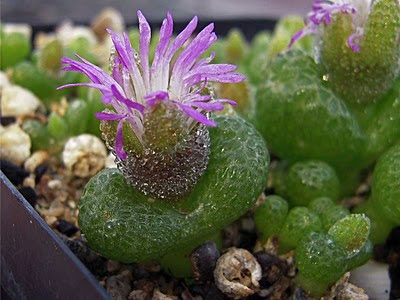 Diplosoma luckhoffii (MRO209, east of Bitterfontein, Western Cape), a little over a year old from seed. Flower about 1 cm wide.
Diplosoma luckhoffii (MRO209, east of Bitterfontein, Western Cape), a little over a year old from seed. Flower about 1 cm wide. Diplosoma luckhoffii is a tiny winter-growing succulent from South Africa. The plants are completely dormant for much of the year, persisting as button-like bodies at or just below the soil surface, protected by a layer of dried up leaf tissue. When rain and heavy dew wet the soil in the cooler months, Diplosoma cracks out of its shell and sends up a pair of mushy green leaves, covered with sparkling, bubbly water-storage cells ("bladder cells"). Flowers are produced in mid- or late winter. The flowers often don't open very well, at least in cultivation, but set seed easily, and even self-pollinate sometimes.
Diplosoma luckhoffii is endemic to the Knersvlakte, a very clearly defined patch of desert only a few hours drive north of Cape Town. The Knersvlakte is characterized by low, rolling topography with frequent patches of snow-white quartz gravel. Not all of that quartz is entirely natural, and one occasionally runs across pieces that were shaped into blades by stone age people. Diplosoma, along with a diverse assemblage of other dwarf succulents in the Aizoaceae (mesemb family) and other families, lives only on soil with a dense cover of quartz rubble; the quartz moderates the temperature at ground level, and makes it possible for stubby little plants to survive the summer without cooking.
The cultivation of D. luckhoffii is fairly difficult. The plants are short lived, not usually surviving for more than three or four years even under ideal conditions, and as a consequence are never available except as seed, as far as I have seen. Diplosoma seed is almost as fine as dust, and should be sown in autumn on the surface of a mineral soil (sandy loam leavened with perlite, vermiculite and course sand) in the pot where they will stay permanently. Seedlings and mature plants alike demand brilliant sunshine, cool night temperatures and careful watering when active. The soil should dry out slightly at the surface between waterings, but remain slightly moist below ground at all times. During the warm-weather dormancy, pots of Diplosoma can be left dry, aside from an occasional misting on sunny days. When happy, Diplosoma sometimes flowers at the end of its first season, though more often the plants rot or terminally desiccate while still pinhead-size.
I have never heard of Diplosoma being successfully cultivated outside of a cool, airy and brightly-lit greenhouse, but I know someone who is trying it under fluorescent lights (right next to the tubes, for maximum illumination). It will be interesting if she succeeds!

6 comments:
Ooooh...this thing is absolutely fascinating, Matt! Great description of it's cells and watering needs, etc. Awesome that you have cultivated it from seed and have gotten such a wonderous bloom!!! I am seriously impressed! I don't think I would undertake it at all. But then again...I wouldn't have been able to as of yet, since I've never been anywhere near South Africa, sadly!!! :)
You might give it a try some time, Julie. I should have noted that a few of the sources I link in the sidebar do have Diplosoma seed. At the moment, Silverhill has D. luckhoffii seed right now, and Mesa Garden has the other species, D. retroversum.
Hi. I've been following your blog for quite some time now, and I find your posts very entertaining and informative. In any case, have you heard of anybody attempting to grow these (or other mesembs for that matter) on a tropical country? I've been wanting to try growing mesembs for quite sometime now, but I'm always thing it will be extremely difficult, if not impossible. Any pointers? Haha. Thanks.
Ron-- I can't imagine it would be easy to keep a cool-weather, short-day growing plant like Diplosoma in the tropics. Maybe indoors with air conditioning, and artificially short daylengths?? Among the compact mesembs, Lithops seem to be especially amenable to hot, humid greenhouse conditions (much more so than the strict winter mesembs, anyway).
Nice one Matt. Looks like a green Strawberry, but I know better. Next time you come to the Philly group, bring one along. You will surely woo the crowd.
Hi Frank-- I hope to see the Philly club again soon, and I'll be sure to bring along a Diplosoma!
Post a Comment